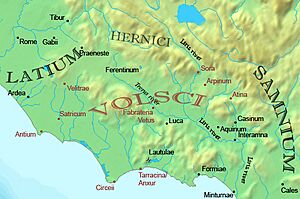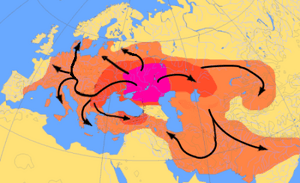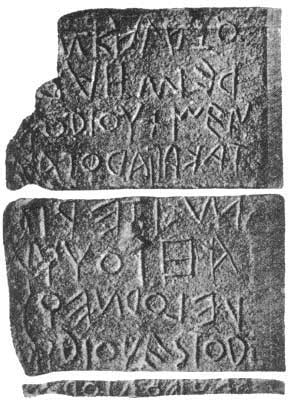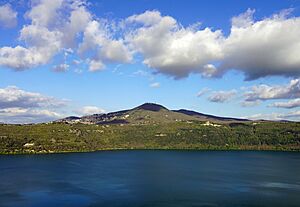Latins (Italic tribe) facts for kids
The Latins were an ancient tribe in Italy. They were among the first people to live in the city of Rome. From about 1000 BC, the Latins lived in a small area called Old Latium. This region was in the central part of the Italian Peninsula, between the Tiber river and Mount Circeo. As Rome grew, the Latins spread into nearby areas.
Their language was Latin, which belongs to the Italic family of languages. People who spoke Italic languages probably moved into Italy during the late Bronze Age (1200–900 BC). The Latins had a special culture called the Latial culture. This culture was part of a larger style called the proto-Villanovan culture.
The Latins kept strong cultural and religious ties. They had common festivals and holy places. This continued even after they were fully united under Rome in 338 BC.
Rome became the biggest and most powerful Latin state around 600 BC. This led to some tense relationships with the other Latin states. Around 500 BC, there were about 14 other Latin states. During the time of the Tarquin kings (around 550–500 BC), Rome seemed to be in charge of the other states.
After the Roman kings were overthrown around 500 BC, Rome and the other Latin states formed a military alliance. They worked together to fight off attacks from mountain tribes like the Volsci and Aequi. But this alliance started to weaken after 390 BC. Rome began to expand aggressively, leading to conflicts with other Latin states. From 341–338 BC, the Latin states fought the Latin War against Rome. They wanted to keep their independence. Rome won this war in 338 BC. The other Latin states were either taken over or became subjects of Rome.
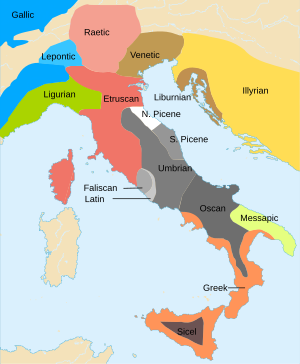
Contents
What Does "Latin" Mean?
The name Latium might come from the Latin word latus. This word means "wide" or "broad." It probably refers to the flat plains of the region, which were different from the many mountains in Italy. If this is true, then Latini would have originally meant "men of the plain."
Where Did the Latins Come From?
The Latins were part of a group of tribes called the Italic tribes. These tribes spoke Indo-European languages. They settled in central and southern Italy during the Iron Age, which started around 900 BC.
Most experts believe that the Latins and other early Italic tribes first came to Italy during the late Bronze Age. They were part of the proto-Villanovan culture. This culture was connected to the larger Urnfield culture system in central Europe. Some historians, like David W. Anthony, suggest that early Latins came from eastern Hungary. Others, like Kristian Kristiansen, link them to cultures in Moravia and Austria.
The Latial culture, which came after, was very similar to the Central European Urnfield and Hallstatt cultures. This suggests a strong connection between these groups.
Some scholars think that the "West Italic" language group, which included Latin, was the first wave of people to arrive. They were later mostly replaced by the "East Italic" (Osco-Umbrian) group. This idea comes from where the West Italic languages were found. Besides Latin, Faliscan and possibly Siculian (spoken in Sicily) were also West Italic. These languages were spoken in small, separate areas. The East Italic languages, like Oscan and Umbrian, were spoken across much of central and southern Italy.
The exact timeline of these migrations is still unclear. We also don't know the exact order of arrival for Italic languages compared to non-Indo-European languages like Etruscan. Most scholars believe Etruscan is an older language that was in Europe before Indo-European speakers arrived.
The Latin Language
The Latins spoke the Latin language, specifically an older form called Old Latin. This language is part of the western branch of the Italic languages, which is a larger part of the Indo-European family.
The oldest known Latin writing is on the Lapis Niger ("Black Stone"). It was found in 1899 in the Roman Forum. This inscription dates back to around 600 BC. This was during the early Roman kingdom. The writing shows that Romans still spoke Latin, even though some historians thought Rome might have become more "Etruscan" in language and culture at that time. The inscription also supports the idea that there were Kings of Rome in this period. It contains the word recei, which means "king" in old Latin.
Latin Culture and Homes
There is no clear archaeological proof that Old Latium had permanent settlements during the Bronze Age. Only a few small pieces of pottery have been found. This suggests that the Latins probably started living in Latium Vetus around 1000 BC.
At first, Latin immigrants likely settled in the low hills. These hills stretched from the central Apennine mountains to the coast. Much of the coastal plain was marshy and unhealthy back then. The Alban Hills were an important early settlement area. These hills are about 20 km (13 mi) southeast of Rome. They have old volcanoes and five lakes, including Lake Nemi and Lake Albano. These hills offered a safe place with plenty of water. The hills where Rome was built, like the Palatine, Capitoline, and Quirinal, also had early settlements.
The Latins started to develop a distinct culture from the surrounding Osco-Umbrian tribes around 1000 BC. From this time, the Latins showed features of the Iron Age Latial culture. This culture was also found in Etruria and the Po valley. The most unique feature of Latial culture was urns shaped like miniature huts. These "hut-urns" were used for cremation burials. They looked like the simple, single-room huts of peasants at the time. These huts were made from mud, straw, and wood. Huts remained the main type of Latin housing until about 650 BC. The most famous example was the Casa Romuli ("Hut of Romulus") on the Palatine Hill in Rome. Legend says Romulus, the founder of Rome, built it himself. It supposedly lasted until the time of Emperor Augustus.
Around 650 BC, cities began to form in Latium. Political city-states were established. Rome is the best example. It started as separate settlements on different hills. These settlements likely joined together around 625 BC. This is when the first buildings were put up in what later became the Roman Forum.
Latin Beliefs and Customs
Ancient Indo-European Traditions
Many scholars believe that the earliest Indo-Europeans were nomadic people from the steppes of southern Russia. Their lives revolved around horses and herding animals. Later groups, like the Scythians, Sarmatians, and Alans, kept similar ways of life. From these common features, scholars have found elements of ancient Indo-European culture in Roman and Latin customs.

Here are some examples:
- Family System: The Indo-Europeans likely had a family system where descent was traced through the father's side. People married outside their close family group. Roman society followed this pattern.
- Supreme Sky-God: The main god of the Indo-Europeans was a male sky-god, called "Father Sky." The chief Latin god, Jupiter, comes from this idea. Jupiter was also linked to thunder and lightning. He was called "Jupiter the Thunderer" and "Jupiter the Thunderbolt-Flinger."
- Fire Worship: The home hearth was very important to Indo-Europeans. They likely worshipped fire. The Romans kept a sacred fire burning forever in the Temple of Vesta. Vesta was the goddess of the hearth. This temple was round, like a hearth, unlike most other Roman temples.
- Swastika Symbol: This symbol was used by Indo-European-speaking peoples in Europe and Asia. It might have symbolized the Sun or the Sky. It was often linked to their supreme Sky-god. In later Roman times, it came to represent the Universe or eternal life.
Latin Tribal Festivals
Even though the Latin city-states often fought each other, they kept strong cultural and religious ties. Their most important shared event was the four-day Latiar, or Feriae Latinae ("Latin Festival"). This festival was held every winter on the sacred mons Albanus (Monte Cavo) in the Alban Hills.
The main part of the festival was sacrifices to Jupiter Latiaris ("Jupiter of Latium"). The sacrificed meat was shared by representatives from all the Latin communities. These rituals had to be done perfectly. If any mistakes were made, they had to be repeated from the beginning. The Latin Festival continued long after Latium Vetus became part of the Roman Republic in 338 BC. Roman consuls later led these festivals.
Other Latin cultural and religious events were held at shared holy places. For example, there was a major shrine to Diana at Aricia. The Roman king Servius Tullius also reportedly founded a common Latin shrine to Diana on the Aventine hill in Rome. There was also an important Latin holy place at Lavinium. Lavinium hosted the cult of the Penates, who were Latin ancestor-gods. A "Sanctuary of the 13 altars" found at Lavinium might have been the site of the Penates cult. Each altar was different, suggesting that each was built by a separate Latin city-state.
Latins in Roman Origin Stories
Aeneas
The Romans developed their own national origin story during the early Roman Republic (500–300 BC). This story centered on Aeneas, a hero who supposedly survived the destruction of Troy by the Greeks. This legend gave the Romans a heroic background and a unique identity separate from other Latins. It also provided a reason for Rome's wars against the Greek cities in southern Italy.
The Roman poet Virgil told the most famous version of this story in his epic poem, the Aeneid (published around AD 20). According to Virgil, the Latin tribe's first king was Latinus. He gave his name to the tribe and founded their first capital, Laurentum. The Trojan hero Aeneas and his men fled Troy after it was captured by the Greeks. After many adventures, Aeneas landed on the coast of Latium near the Tiber river. King Latinus first tried to drive them away but was defeated. Later, he accepted Aeneas as an ally and allowed him to marry his daughter, Lavinia.
Aeneas supposedly founded the city of Lavinium, named after his wife. It became the Latin capital after Latinus died. Aeneas' son, Ascanius, then founded a new city, Alba Longa, in the Alban Hills. Alba Longa replaced Lavinium as the capital. Alba Longa supposedly remained the Latin capital for about 400 years. Then, Aeneas' descendant, Romulus, founded Rome in 753 BC. Later, under King Tullus Hostilius, the Romans destroyed Alba Longa and moved its people to the Caelian Hill in Rome.
There is debate about when and how the Romans adopted Aeneas as an ancestor. Some think the Romans got the story from the Etruscans, who got it from the Greeks. There is evidence that Etruscans knew the Aeneas legend by 500 BC. However, many scholars believe that the Latins had no real historical connection to Aeneas. They also think the city of Alba Longa itself was probably a myth. Early Latin remains in the Alban lake area show small villages, not a large city-state.
Romulus
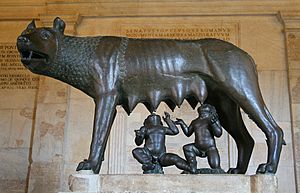
Romulus is famous for the legend of the she-wolf (lupa) who saved him and his twin brother Remus. The twins were thrown into the Tiber river by their wicked uncle, Amulius. The she-wolf found them in a cave on the Palatine Hill and kept them alive. Later, shepherds rescued them.
Most scholars today believe Romulus is a mythical character. His name might have been made up to give Rome a founding hero, which was common in ancient myths. It's possible that Romulus was named after Rome, rather than the other way around. The name "Romulus" means "Roman" or "little Roman."
Unlike the Aeneas legend, which came from outside the Latin world, the Romulus story of the she-wolf seems to be a true Latin myth.
How Rome United the Latins (550–338 BC)
Ancient sources say there were 30 Latin communities for religious festivals. This same number is sometimes wrongly given for the Romano-Latin military alliance, called the "Latin League" by modern scholars. However, around 500 BC, there were probably only 15 independent Latin city-states in Latium Vetus, including Rome. The other 15 were taken over by these larger states, especially Rome, as they expanded.
The table below shows the estimated size of Latin city-states around 500 BC:
| Name of city |
Modern name/ location |
Est. territory (km2) |
|---|---|---|
| Roma | Roma | 822 |
| Tibur | Tivoli | 351 |
| Praeneste | Palestrina | 263 |
| Ardea | Ardea | 199 |
| Lavinium | Pratica di Mare, Pomezia | 164 |
| Lanuvium | Lanuvio | 84 |
| Labici | Monte Compatri | 72 |
| Nomentum | Mentana | 72 |
| Gabii | Castiglione | 54 |
| Fidenae | Villa Spada, Rome | 51 |
| Tusculum | near Frascati | 50 |
| Aricia | Ariccia | 45 |
| Pedum | Gallicano nel Lazio | 43 |
| Crustumerium | Marcigliana Vecchia, Settebagni | 40 |
| Ficula | 37 | |
| Total Size of Latium Vetus | 2,347 |
This table shows how small Latium Vetus was. Rome was by far the largest state, controlling about 35% of the total land. The next four largest states were much smaller than Rome. The other ten were even tinier.
From early on, Rome, as the largest and most powerful member, controlled the relationships between the Latin city-states. Archaeological findings since the 1970s have shown that Rome was a unified city by about 625 BC. By 550 BC, it was the second-largest city in Italy. Rome was about half the size of Athens at that time and much larger than any other Latin city.

Rome's size at this time supports the idea that during the late regal period (550–500 BC), under the Tarquin kings, Rome gained control over the other cities of Old Latium. According to the historian Livy, King Tarquin the Proud formed a military alliance with the Latin city-states under Roman leadership. Rome's control over Latium Vetus seems to be confirmed by the first recorded treaty between Rome and Carthage, dated to 507 BC. This treaty described Latin cities like Lavinium and Ardea as "Roman subjects." It also stated that if Carthage captured any Latin city, it had to hand it over to Rome.
The end of the Roman monarchy was likely a long and difficult process. The Etruscan king Lars Porsenna invaded Roman territory during this time. Any threat of an Etruscan takeover of Rome ended when Porsenna was defeated at Aricia in 504 BC.
After this, a war broke out between Rome and the other Latin city-states. They probably tried to regain their independence during Rome's political troubles. Tusculum and Aricia seemed to lead an anti-Roman alliance. The Latins also had support from the Volsci tribe and the deposed Roman king Tarquin the Proud.
Rome eventually won, with a major victory over the Latin forces at Lake Regillus between 499-493 BC.
Instead of taking back full control, Rome formed a military alliance with the Latins on equal terms. This was called the foedus Cassianum (Cassian treaty). It promised lasting peace, mutual help in case of attack, and equal sharing of war spoils. It also likely meant that command of the allied forces would switch between a Roman and a Latin commander each year. This alliance was probably formed because of the danger from Italic mountain tribes who were invading the lowlands after 500 BC. The Latins faced repeated attacks from the Hernici, Aequi, and Volsci.
The new Romano-Latin alliance successfully pushed back these mountain tribes from 500–400 BC. After Rome recovered from a major Gallic invasion in 390 BC, it began to expand. Rome took over several neighboring Latin city-states. The growing threat from Rome led stronger Latin states like Praeneste to fight back, often with the help of mountain tribes like the Volsci.
Finally, in 341 BC, all the Latin city-states united in a last attempt to keep their independence. This was the Latin War. It ended in 338 BC with a clear Roman victory. Rome then took over most of Latium Vetus. A few larger Latin states, like Praeneste and Tibur, were allowed to keep some independence. But they were still under Rome's control as socii ("allies"), tied to Rome by military treaties.
Genetic Studies
A genetic study in 2019 looked at the remains of six Latin males buried near Rome between 900 BC and 200 BC. These individuals were different from earlier populations in Italy because they had about 30% "steppe ancestry." Two of the six individuals also had a mix of local Iron Age ancestry and ancestry from the Eastern Mediterranean.
Compared to modern people, four of the six were most similar to people from Northern and Central Italy, and then Spain. The other two were closest to Southern Italians. Overall, the genetic differences between the Latins, Etruscans, and the earlier proto-Villanovan people of Italy were very small.
People from the city of Rome during the Roman Empire (27 BCE – 300 CE) were genetically very different from Rome's original founding populations. They were more similar to people from the Eastern Mediterranean and Middle East. This suggests that many merchants and enslaved people migrated to Rome from these areas.
After the Imperial era, Rome's population decreased greatly. During this time, more local Italian ancestry became common in Rome. By the Middle Ages, the people of Rome again looked genetically similar to people from central and southern Europe.
Physical Appearance
Studies on ancient DNA have given us information about the eye, hair, and skin color of people from the Iron Age/Republican period in Latium and Abruzzo.
For the Iron Age/Republic period (11 individuals):
- Eye color: 27% had blue eyes, 73% had dark eyes.
- Hair color: 9% had blond or dark blond hair, 91% had dark brown or black hair.
- Skin color: 82% had intermediate skin, 9% had intermediate or dark skin, and 9% had dark or very dark skin.
For the Medieval/Early Modern period (27 individuals from Latium):
- Eye color: 26% had blue eyes, 74% had dark eyes.
- Hair color: 22% had blond or dark blond hair, 11% had red hair, and 67% had dark brown or black hair.
- Skin color: 15% had pale skin, 68% had intermediate skin, 10% had intermediate or dark skin, and 7% had dark or very dark skin.
See also
- List of ancient peoples of Italy
- List of ancient Italic peoples
- Valle Latina


